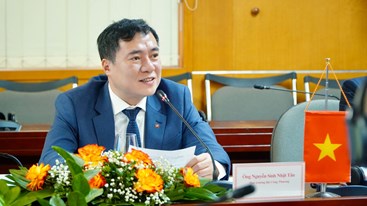Monday, 06/05/2024 | 07:16 GMT+7
Each year, the entire system of public lighting throughout the country consumes a huge amount of power with great waste. When staff members want to adjust the lighting time, they have to adjust manually at each station. Wishing to ease the job of managing, monitoring and regulating lighting energy efficiency, two authors Nguyen Trong Kien and Nguyen Van Hoang have spent time studying the system and come up with an impressive solution to the problem. Their newly developed system promises to help regulating lighting time period more reasonably, providing more options suitable for each particular condition, such as to use 100% capacity at peak hours for lighting and only 50% during off-peak hours, or seasonally adjusted according to Vietnamese climate.

The demand receiver at the stations consists of: a block for measuring leakage current and sending data to the micro-controller - this is an industry standard measuring device imported from Malaysia; a micro-controller block for receiving and processing input and output signals sent from the central control software, a GSM modem for receiving control messages from the center and sending back reporting messages to the center for monitoring purpose; a power source to provide power for the whole system, with backup battery of in case of power cut; a relay block for controlling the electric switches to turn on/off the lighting bulbs. Whenever the leakage current, measured by the measuring block, is larger than the default value, the system will cut off power and send reports to the center. The range limited for leakage currents are from 20 mA to 1000 mA.
The operation principle of the system can be summarized as follow: When entering the stations, the system will alert if not being shut down and send the signals to the center and send message to the station manager. Upon leaving the station, a protection system is automatically turned on within 10 seconds and a report on an active protection is immediately sent to center. The highlight of the system is a configuration completely using messages with specific language for sending information, including protective password for data security in the system.
The study process has revealed some outstanding advantages of the system. It can tell the amount of electricity leakage and power consumption of each lighting station each month. There are various lighting modes suitable for a particular period, making it easier to detect lamp breakdown. The management procedure is completely computerized, thus detailed reports can be produced for each station. In addition, installation cost is rather low, yet operation process is very fast and accurate while maintenance is very convenient (remote maintenance is possible); and most importantly, data security level is rather high because this is an isolated system not connected to outside network.
Besides those strengths, the authors also asserted that the project is highly practical as it is very energy efficient and also helps save management costs. A good example is that with such a big number of lights in the entire city, by turning off lights just one hour earlier or using a half of lighting capacity during off-peak hours, a significant amount of power can be saved. Furthermore, the prompt reporting system also increases the credibility of the system by quickly informing the manager on electricity leakage condition in order to carry out timely solution. With today’s vigorous development in the telecommunication network, data transfer between devices is highly secured, adding more credibility to the system.
In addition, sending information through
SMS will significantly reduce expenses for maintenance and management of the
center, compared with an Internet-based system. In this project, the devices
are installed with maximum security and stability, using password protected
protocol to connect with the center. Besides, outside SMS messages are not able
to enter the system because the stations are managed by an independent center
via a private GSM modem. At the moment the system is being used at BTS HCM089
station in Thanh Da, Binh Thanh Distric,
By Nguyen An



.png?w=367&h=206&mode=crop)




.jpg?w=367&h=206&mode=crop) Energy efficiency and conservation usage is an important aspect of the national energy development strategy
05/03/2024
Energy efficiency and conservation usage is an important aspect of the national energy development strategy
05/03/2024
 Challenges and Opportunities to promote energy efficiency market in Vietnam
Challenges and Opportunities to promote energy efficiency market in Vietnam
 The Ministry of Industry and Trade requests government agencies to coordinate in organizing Earth Hour 2024
The Ministry of Industry and Trade requests government agencies to coordinate in organizing Earth Hour 2024
 Consultation on Energy Efficiency Boiler Catalogue and Wood Drying Guideline
Consultation on Energy Efficiency Boiler Catalogue and Wood Drying Guideline
 Son Ha Co., Ltd, applies energy efficiency and conservation measures
Son Ha Co., Ltd, applies energy efficiency and conservation measures
.png?w=367&h=206&mode=crop) Request for expression of interest - C2.1.13: Capacity Building on energy efficiency policies development
Request for expression of interest - C2.1.13: Capacity Building on energy efficiency policies development
 Phuc Kien Co., Ltd., is effectively implementing energy-saving measures
Phuc Kien Co., Ltd., is effectively implementing energy-saving measures
 Request for expression of interest - C2.1.12: Independent monitoring of safeguards implementation
Request for expression of interest - C2.1.12: Independent monitoring of safeguards implementation